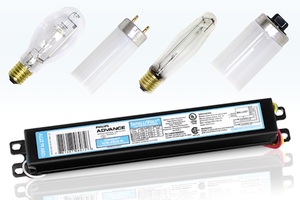The Energy Policy Act of 2005 not only bans the sale and production of incandescent light bulbs in 2012, but also bans production of old magnetic ballasts by July 1st, 2010.

Earlier this month Sylvania ceased production on its old magnetic ballasts in favor of their energy efficient electronic ballasts. They expect to sell the last of their magnetic ballasts by August, and have plenty of energy efficient electronic ballasts available for replacements.
Just like incandescent and compact fluorescent light bulbs, electronic ballasts do the same job as magnetic, but they do it much better. Ballasts are needed to regulate the electrical current that flows through the arc tubes of fluorescent and HID (high intensity discharge) lights. They also provide the high voltage spikes required to ignite the same.
Magnetic Ballasts
Old magnetic ballasts are the cause of the fluorescent lamp flicker that has turned so many people off of fluorescent lighting. The flicker occurs because the lamp actually blinks about 120 times per second whenever the voltage crosses 0 volts. This is related to the inner workings of the ballast of which I am not very familiar, so unfortunately I can't explain it further than that. Magnetic ballasts also have a limited range of voltage and frequency input, which makes it easier for lamps to fail in certain conditions. Aside from all this, magnetic ballasts have a very simple design, and rarely does the ballast itself fail. This is why they've been in use for over 60 years!
Electronic Ballasts
Electronic ballasts use solid state electronic technology to convert AC to DC and then back to AC at a very high frequency. The frequency is so high that it eliminates any visible flicker, which is one of the reasons why fluorescent lighting today is so improved. Unlike magnetic ballasts which have a limited range of voltage and frequency input, electronic ballasts have fully regulated circuits capable of maintaining proper lamp conditions at a wide range of voltages and frequencies. Electronic ballasts are also much lighter than magnetic, but that really only matters during installation.
With the ban of magnetic ballasts, we can expect fluorescent lighting everywhere to be more uniformly pleasant. No more flicker!



